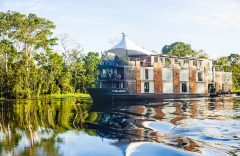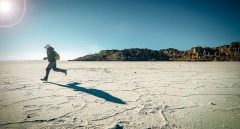Road Testing the “Trail-Blazer”: Part Two

I've never been to hell, but if I had to imagine the journey there I would model it on the bus to Santa Elena, Venezuela.
Ridiculously loud Latin American music videos; a scratched B-movie sequel dubbed into Spanish (which skipped along for two hours before we were treated to an hour of the DVD menu on infinite repeat); Arctic air conditioning and interminable stops were just some of the many torments.
When we finally arrived at seven in the morning, we were shown to a guesthouse where we showered off the residue of Beelzebub's bus ride. However, it was only to be a flying visit, as the whole purpose of our presence in Santa Elena that day was to cross into Brazil, and onwards to Guyana. Still largely isolated from the outside world, Guyana has no land crossing to neighbouring Venezuela, so we were going to have to do things the hard way.
One more long and bone-rattling journey later, we arrived in Rock View, in the heart of the Guyanese savannah. We were here to visit the Canopy Walkway at Iwokrama. Suspended 100 feet in the air, the walkway allows you to amble through the forest at treetop-height and spot the wildlife sheltering beneath. This wildlife is one of Guyana’s main draws: the barely-trodden rainforest is home to jaguars, rare bird species, scarlet macaws, giant river otters, lizards... the list goes on.
The plan for the afternoon was to catch the bus to Georgetown, but we received radio communication that the bus was cancelled. So in true Kerouac spirit (that was the point of the trip, after all) we decided to go down to the dirt road – the only road – and try to hitch a ride. We sat in the orange dirt, throwing rocks at signs, piling pebbles into potholes, talking of fanciful plans to see the guts of the country the only way you can: by thumb. Giant bees the size of golf balls took an interest in our backpacks and had to be periodically scared away with bits of bush. I lay by the side of the road reading 'Big Sur' and hoping to rouse the spirit of old Jack to get us a ride. But so remote was this part of the world that close to five hours spent by the roadside yielded just one potential ride, and it was full!
The road closed at 4.30pm, so we made our way back up to the jungle lodge, dreading the early morning start to catch a ride at five in the morning, in the dark, on a road known to be a favourite hang-out of jaguars. To make matters worse, a bushmaster snake had recently been spotted on the same road, so now we not only had to be keeping a sharp tired eye out for large deadly cats, but also large deadly snakes.
We reached Georgetown alive and sweaty and tired after one hell of a ride. We were a day late so our visit was cut a little short, but from what I saw of it, Georgetown was amazing. Houses consisted of wooden villas raised up on supports, some rotting into themselves, collapsing into the little trench moats around them, others pristine like American summer houses on the shores of Cape Cod. Georgetown is how I imagine New Orleans in its heyday, but with jazz replaced by a Caribbean reggae beat, and with a touch more rum.
Next stop was another capital with a frontier feel: Paramaribo, in the Dutch colony of Suriname. Again we were surrounded by old wooden buildings, bleached relics of the unfailing sunshine, with paint flakes falling from the walls and a generous sprinkling of rust. It was 38 degrees and after three hours in the midday sun, it all became too much and I decided I had to find a corner to quietly go and die in. Luckily instead I managed to shelter in a cafe, drink my body weight in Diet Coke and scuttle back to the guesthouse on the other side of town. If I had stayed out a second longer in the heat, I think my skin would have melted along with the insides of my mind.
One thing that is very odd about Paramaribo, apart from the strange sense of alienation for the non-Dutch, is that the language spoken by the locals isn't Dutch. It's a weird mix of French, Brazilian Portuguese, Dutch and English baked in the Caribbean, and it’s known as Sranan Tongo.
We left Paramaribo for the Marouini river, which acts as a natural border between this tiny country and similarly miniscule French Guiana. As we unpacked our bags from the car and passed through the single passport control hut, the weather in an instant went from beaming shards of sunlight to a torrential downpour, and by the time we were half way across the watery crossing in our little motorized bathtub, we had to stop. We floated there in the rain for ten minutes or so, before – again in an instant – the rain had gone and the naked sun and heat came back with a vengeance.
We hitched a ride to the departure point for the capital Cayenne. Our driver was from Amsterdam, had learnt English in Paris and French in Suriname, and was now living with his girlfriend and two kids in French Guiana. His cheeky grin was a refreshing change to the solemn faces of the Dutch in Suriname.
The next day we wandered around Cayenne, which is a basically a small French town – apart from the fact it's the capital of a South American country. In fact, French Guiana as a whole would be indistinguishable from France were it not for the jungle setting. All the road markings and signs are French. Even the cars that lie rotting upside down and covered in vines, slowly being reclaimed by nature by the side of the road, are, upon closer inspection, old Renault Clios.
The following morning we left for Kourou, the international space station buried in a remote corner of French Guiana. In the evening we watched a classic of the nouvelle vague, Breathless, with Jean Paul Belmondo looking agonisingly cool. We slept well, knowing in the morning we would be departing for the infamous Devil's Island.
The Salvation Islands were, until 1955, a penal colony, though as you approach them they more closely resemble a paradise: a trio of idyllic islands situated 10km offshore in the heartless blue sea, rocks brushed with sunlight, and coconut palms arching out over the rocky shoreline. From our seaborne vantage point it was hard to grasp the reality that these tropical islands stand as a dark marker of incarceration and cruelty.
The main island, Isle du Royale, still guards over the remains of the chapel, the hospital, some of the isolation cells and few of the buildings that now act as accommodation for guests. A five-minute boat ride away, the second Island, Isle Saint-Joseph, is a huge, completely deserted, forgotten prison complex. We wandered around alone for the best part of two hours, gawping at buildings that the jungle has clawed back. The roots of the coconut trees have broken through the walls of the cells and burst more twisted iron bars out of windows than a thousand prisoners could have ever done. The symbolism was striking: giant trees ripped through almost every cell, their branches adorned with a pandemonium of parrots.
The most infamous and smallest of the three islands, Isle du Diable (Devil's Island) is inaccessible. The waters that surround the isle are not only treacherous because of the deep under currents that can suck a boat under, but are also infested with man-eating sharks. Devil's Island is infamous because of the inhuman conditions prisoners were kept in right up until the 50s. No-one ever escaped. It seemed an inmate’s only route out was to die – either naturally or through execution at the whim of the guards – and be thrown to the circling sharks. Supposedly only children and prison guards were granted the dignity of a proper burial.
I sat by the shore in the evening, watching the sun set and wondering how many ghosts of how many cursed men were looking back at me from the unreachable island. Even knowing their stories, it was hard to reconcile the postcard views with the intolerable suffering that had taken place there.
After a rather chilling night on the islands, we left for the mainland, entertained by kids on a school trip singing Old Macdonald in French. We would fly the next day from Cayenne.
I'd had an amazing three weeks battling hostile jungles, traversing waterfalls and careening across borders at maniac speeds in the twilight. All five of the relatively undeveloped countries we had crossed through had been unique and stunning in their respective ways. I was left feeling envious of my dad, who’d be back to do it all again – twice.
Tailor-made holidays
Flexible, custom-made holidays to Latin America created to match your exact requirements: our tailor-made itineraries are as unique as the clients for whom they are designed.
Design my tripPapagaio
Your edit for Latin American inspiration
Our exciting range of articles on Latin America explore everything from iconic destinations and lesser-known cultural gems to delicious traditional recipes. You’ll also find exclusive travel tips, first-hand client reviews and the chance to get your personal questions answered by our travel experts.
View Extraordinary Inspiration






































